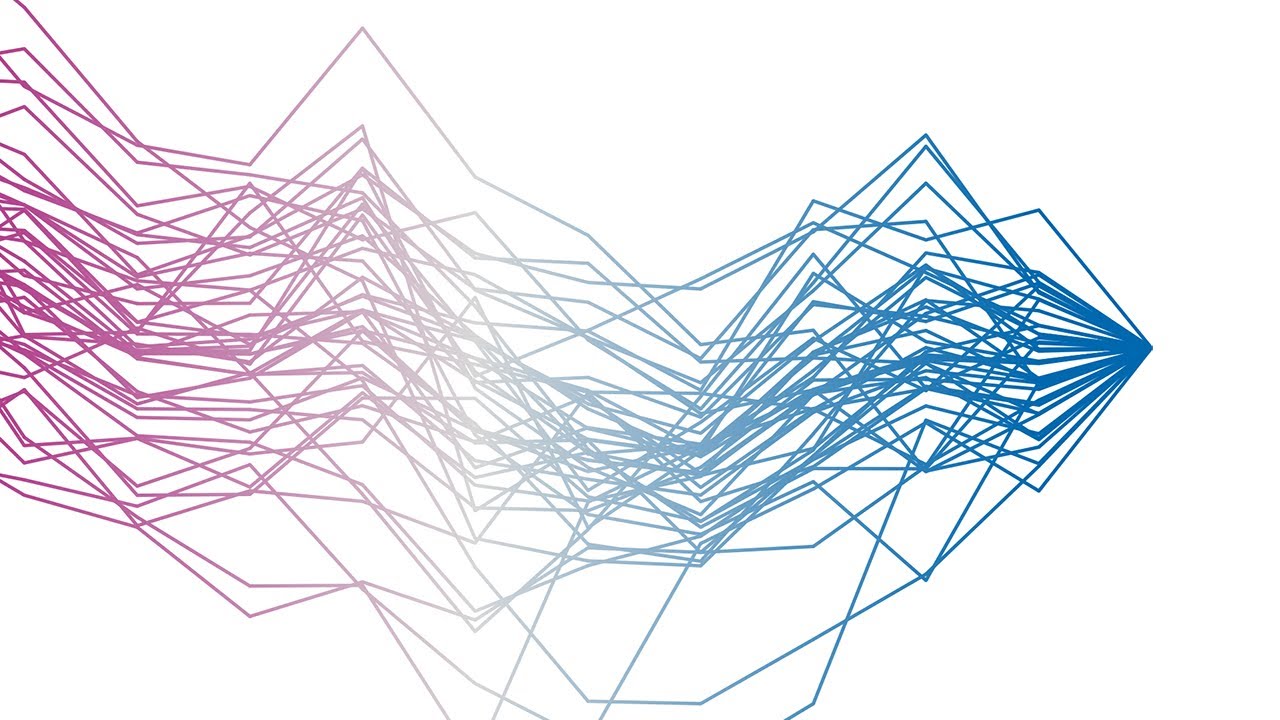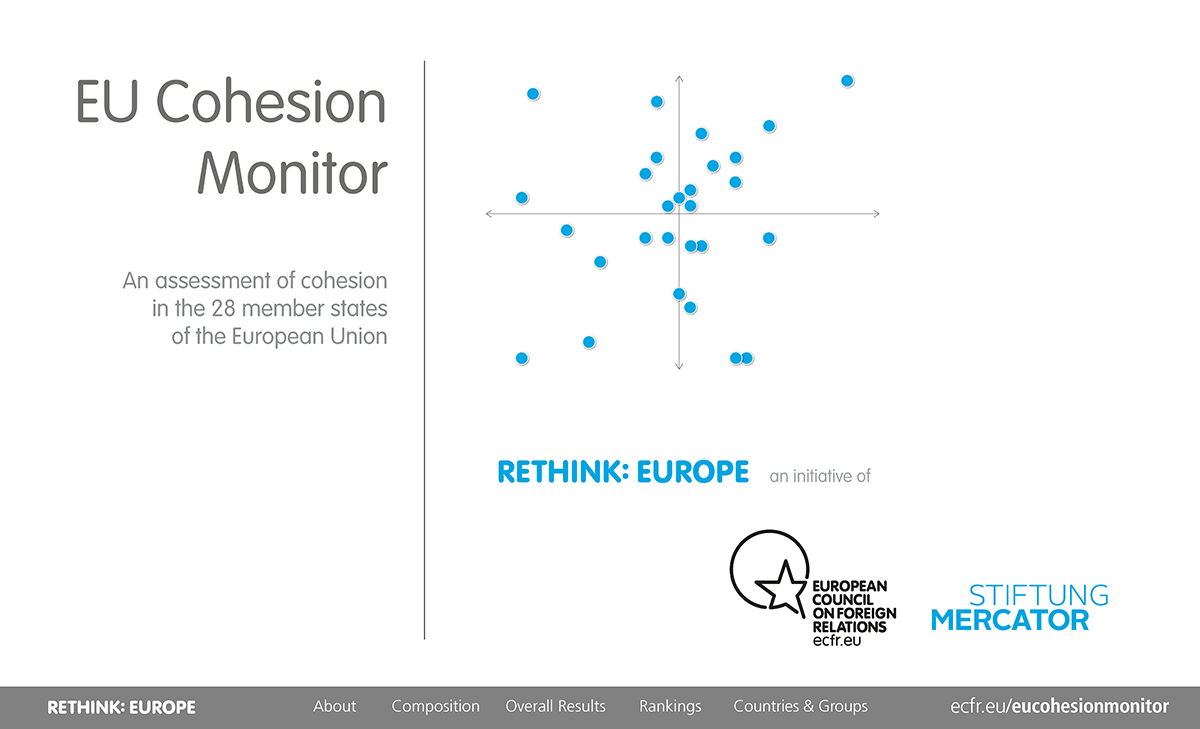EU Cohesion Monitor
Cohesion is the glue that holds Europe together. It is shaped by a variety of factors that make Europeans more willing to cooperate with one another. These factors include the connections between societies and economies, people-to-people contacts across borders, as well as attitudes and expectations.
The EU Cohesion Monitor brings all these factors together in a comprehensive measurement of European cohesion across time for all EU member states and the United Kingdom. This updated and extended edition of the Monitor includes the cohesion ranking and trends from 2007 to 2019.
The EU Cohesion Monitor is part of the Rethink: Europe initiative by the European Council on Foreign Relations and Stiftung Mercator.
FAQ
What is the EU Cohesion Monitor?
The EU Cohesion Monitor is an index of the 27 member states of the European Union and the United Kingdom and their readiness for joint action and cooperation. It measures how strong European cohesion is, how it is changing, and how much it differs between the 28 countries.
The EU Cohesion Monitor’s central assumption is that European cohesion is a precondition for Europe’s capacity to act, and that acting together successfully, in turn, strengthens cohesion.
Whereas previous versions of the EU Cohesion Monitor were presented in PDF format, the 2020 edition has been designed as an interactive online tool
What is the difference between cooperation and cohesion?
We assume that successful cooperation between individuals as well as societies and countries will strengthen mutual bonds, shared incentives, and common experiences.
Cohesion is broader in that it focuses on the disposition of collective actors, in both individual and structural terms, to work together.
The EU Cohesion Monitor looks not only at actual cooperation but includes measures for the awareness, readiness, and cooperation-mindedness of societies.
What is the difference between individual and structural cohesion?
Individual cohesion describes people’s experiences, attitudes, beliefs, and well-being. Structural cohesion is shaped by connections and practices between countries on the macro level, including the actions of economic, political, and cultural elites.
The two dimensions often complement each other – but not always. The EU Cohesion Monitor displays both dimensions separately to make these differences visible.
What recommendations emerge from the EU Cohesion Monitor?
Cohesion is a central resource needed for European cooperation. Strategies to strengthen cohesion need to address both its individual as well as its structural dimension. They should also address each country’s distinct cohesion profile.
Cohesion is not subject to swift changes. Policymakers pursuing measures to boost cohesion should be ready for the long haul. The differences in cohesion between countries and over time also means that not only policymakers and governments are encouraged to address it. Cohesion is just as much a field of engagement for civil-society organisations and EU citizens.
How does the EU Cohesion Monitor work?
The EU Cohesion Monitor combines a total of 42 factors to measure cohesion along five individual and five structural cohesion indicators. The individual indicators quantify cohesion at the level of citizens’ experiences, opinions, and expectations. The structural indicators measure cohesion at the macro level of the state and the economy. The Design – Composition chapter sets out a detailed overview of all indicators, their factors, and sources. The Design – Groups chapter provides information on country groups, such as the Eurogroup or the Visegrad Four.
Overall cohesion scores are calculated in two steps. Firstly, the simple averages of the five individual and the five structural indicators are taken. Secondly, the two resulting scores for both dimensions are averaged again. For detailed information on methodology and calculations, read “A blueprint for measuring European cohesion”.
How do I use the EU Cohesion Monitor?
The menu along the top of the interactive online tool displays the various chapters. By clicking on the titles, you can jump directly to any one of them. Within each chapter, additional menus allow you to sort the information by country, grouping, and year as well as by the 42 factors, ten indicators, and two dimensions along which we measure cohesion. The lightbulb icon in the top-right corner provides explanations of the main features of each chapter. Tooltips provide additional information on individual data points.
Can I use EU Cohesion Monitor scores for my work? Are the data sets available?
Yes. The data underlying and generated by the EU Cohesion Monitor can be accessed in its entirety and free of charge.
Please cite as follows: EU Cohesion Monitor, European Council on Foreign Relations, December 2020, available at ecfr.eu/special/eucohesionmonitor/.
Acknowledgments
In producing the 2020 edition of the EU Cohesion Monitor, we followed in the footsteps of former ECFR colleagues Josef Janning, Almut Möller, and Christoph Klavehn, who developed and continuously expanded and improved upon the index from 2016 onward. We are grateful to them for laying the most solid foundation for us to build on. We also thank Christoph Klavehn for his contributions to visualising the latest data for the 2020 edition. Finally, we want to extend our gratitude to our colleagues at ECFR for their helpful comments and suggestions on the project and to Teresa Spancken and Stiftung Mercator for their enduring support of ECFR and the Rethink: Europe initiative.
Publications
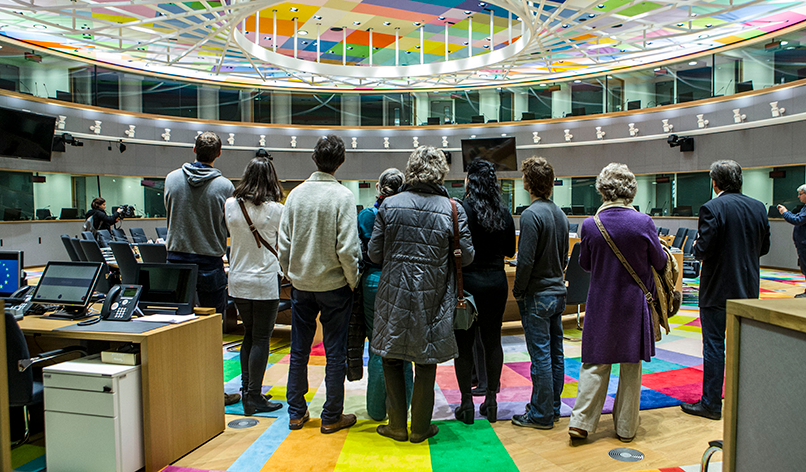
EU Cohesion Monitor 2019: The untold story of European resilience
by Almut Möller -11th April, 2019
ECFR’s newly released Cohesion Monitor charts a decade of upheaval in Europe – and reveals that European cohesion is now, in fact, stronger than in the pre-crisis year of 2007.
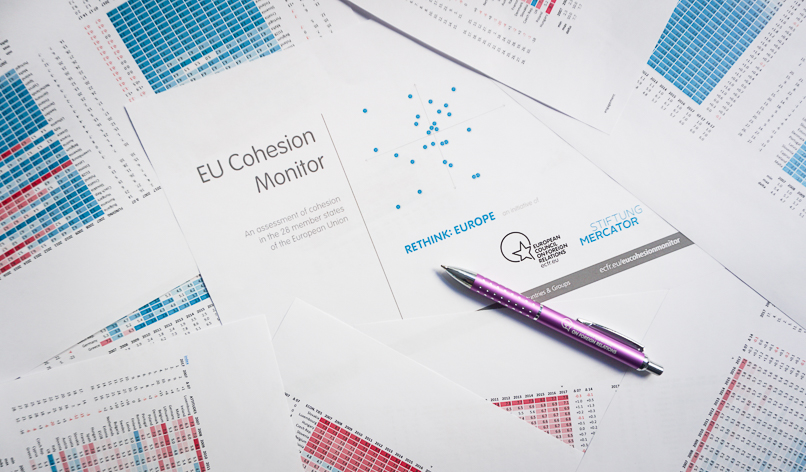
A blueprint for measuring European cohesion
by Christoph Klavehn -11th April, 2019
Learn about the the methodological framework of the EU Cohesion Monitor and the quest for better pan-European data.

Shoring up European cohesion: The multiplier effect of political engagement
by Timor Landherr & Oliver Unverdorben – 29th March, 2019
Only by comprehensively democratising the European project can we meaningfully strengthen European cohesion.
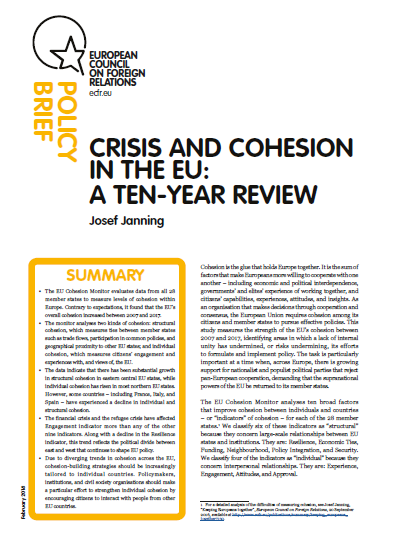
Crisis and Cohesion in the European Union: A Ten-Year Review
by Josef Janning – 6th February, 2018
EU’s overall cohesion increased between 2007 and 2017
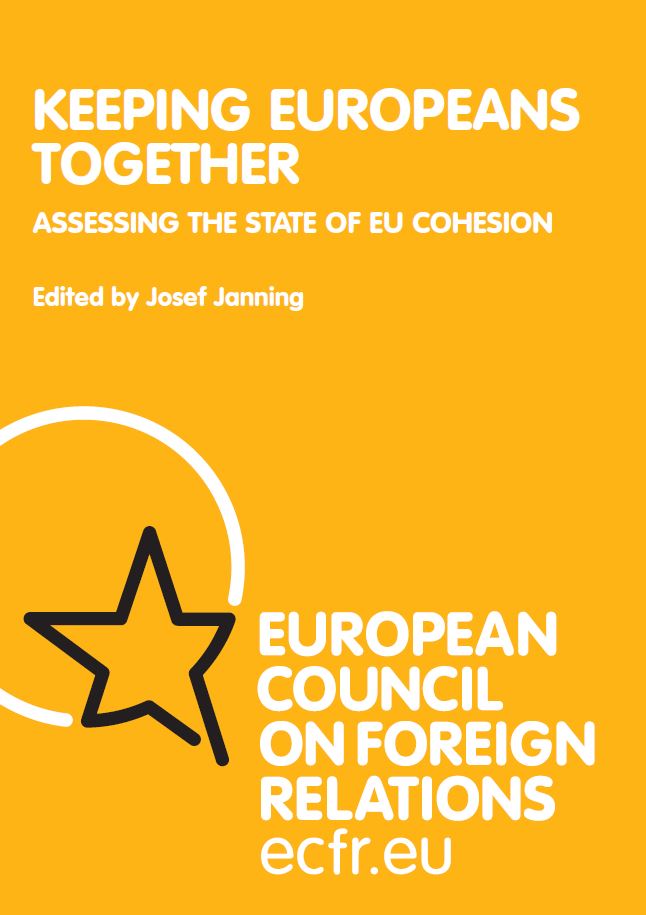
Keeping Europeans together
by Josef Janning (editor) – 20th September, 2016
This volume reflects the diversity of European cohesion. It provides the national context and personal assessments from 28 EU member states.

Making sense of Europe’s cohestion
by Josef Janning – 11th May, 2016
Making sense of Europe’s cohesion challenge. Josef Janning explains the EU Cohesion Monitor and what it means to be a European.
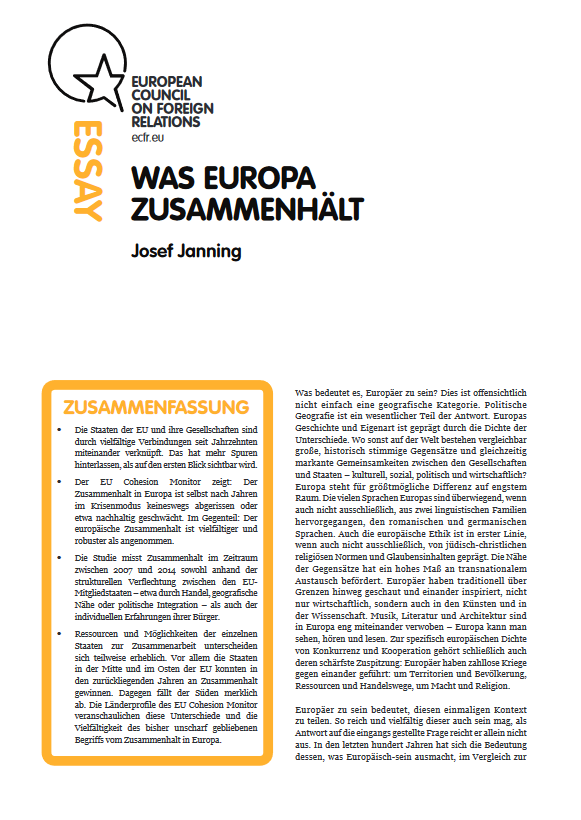
Was Europa zusammenhält
by Josef Janning – 11th May, 2016
Eine neue Studie des ECFR zeigt, dass der europäische Zusammenhalt zugenommen hat – auch nach Jahren im Krisenmodus

Un análisis de la cohesión europea y sus desafíos
by Josef Janning – 11th May, 2016
¿Cuán cohesionada ha estado la UE de cara a los retos que enfrenta?
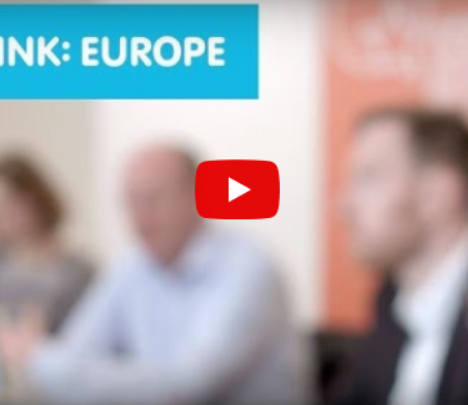
EU Cohesion Monitor Video 2016
11th May, 2016
How EU are we and what is European cohesion? Today we launch the EU Cohesion Monitor, a new instrument that assesses the willingness of Europeans to work together.
Related content
2020
- The interdependence of European solidarity, European cohesion and a European public sphere By Jana Puglierin
2019
- Germany at the helm: Can it bring Europe together in 2020? By André Hein
- Denmark’s shift towards an ever greener union. By Jakob Dreyer and Christine Nissen
- European cohesion and the Visegrád group: The importance of hearts and minds. By Olga Gyárfášová
- Cohesion or disintegration? Germany’s European election campaign. By Josef Janning
- Shoring up European cohesion: The multiplier effect of political engagement. By Timor Landherr & Oliver Unverdorben
The European Council on Foreign Relations does not take collective positions. ECFR publications only represent the views of their individual authors.

